Baby Origami Maybe You Can Change It Up
A (adequately) brief history of origami
"When yous fold, the ritual and the human action of creation is more important than the last issue. When your easily are busy your heart is serene" - credited to Akira Yoshizawa, the grandpa of mod origami
Hero paradigm: Annoy, designed Matthieu Chicou�ne
If y'all accept tried to turn a piece of thin, square paper into folded crane you lot may take not found this a calming activity. To the uninitiated paper folding can appear a mysterious fine art as one's previously reliable and capable fingers get strangely maladroit. Who would have idea folding a piece of paper exactly in one-half could be so hard?!
Origami has though, increasingly been recognised equally being an effective mode to practice mindfulness and to increase well-being. It possesses a meditative quality. It is deadening and precise, each fold carefully made. It requires patience and a single-minded focus to follow the steps and gradually bring the model to life. And it has been shown that origami can aid relaxation, concentration, hand eye co-ordination and memory. Truly a remedy for our times.
But where and when did newspaper folding originate? Is information technology equally old as the hills or this week'south latest mode? And how did this Japanese pastime come to be good across the globe?
Back to the beginning
For newspaper folding only one material is required. Paper. And paper is fragile which means that sadly no ancient origami models folded by Emperors of old be to prove its heritage. Information technology has frequently been assumed that China, where in 105 A.D. Cai Lun (likewise written Ts'ai Lun) is credited with the invention of newspaper, must have been the birthplace of paper folding. Much that is Japanese was indeed introduced from China - kanji characters, Buddhism, gyoza dumplings to name only three - but at that place is no business firm evidence that the Chinese are the originators of paper folding. However, it seems unlikely that having invented paper nobody in China thought to fold it!
Primeval Japanese folds
The applied science for manufacturing paper, was imported from China, via Korea into Nippon in the 6th Century by Buddhist monks, thus kickoff the Japanese love thing with newspaper. Over time production techniques were improved and perfected creating the beautiful washi paper that the Japanese are so famous for. Just in our search for the earliest folds, at that place is no prove that the monks folded paper or used it for anything other than writing on.
It is not until the late 17th century that we find the oldest unequivocal document of origami in Nihon, a curt poem composed by Ihara Saikaku in 1680. It reads: "Rosei-ga yume-no cho-wa orisue" - the collywobbles in Rosei's dream would exist origami. (1)
The reference hither is to an origami model called Ocho Meccho (male person and female collywobbles) which even today are used to wrap sake bottles at Shinto wedding ceremonies. How far these models engagement back is unclear, just there is some evidence that equally long agone as the Heian Catamenia (794-1185) this fold was being used.
Whatever the precise date, ocho and meccho are historically important because they are the commencement known examples of representational origami, the forerunners of the ubiquitous origami crane which is the symbol of modern origami. (ii)
Prototype - The Wedding Ceremony Sake Set up shown on the right shows the collywobbles attached to sake serving kettles (choshi) which wait like tea pots. In contrast, like models are attached to sake bottles which look like decanters during New Year celebrations. Above this are the diagrams for the paper fold for each one. (Origami Resources Eye)
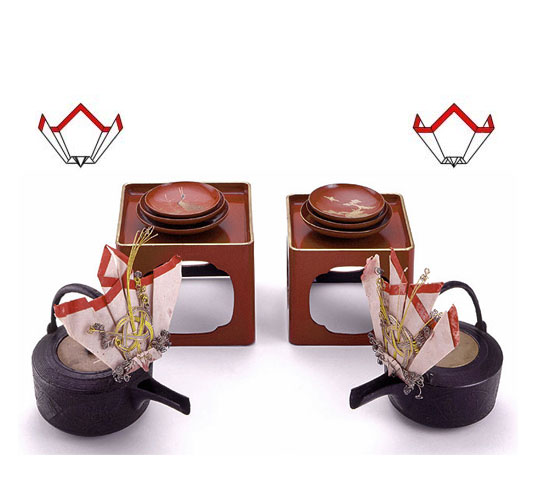
In that location are other ceremonial folds that appointment back at least to the Edo era and some historians claim every bit far back as the twelfth Century. The Japanese are well known for their etiquette around souvenir giving, and paper adornments were folded in different ways to symbolise unlike things.
Noshi is a folded decorative element attached to gifts at times of celebration - weddings, births, coming of age twenty-four hours - as a token of good luck (3). "Tsutsumi" was a formal gift wrapper. And "origami tsuki" was a folded piece of newspaper that accompanied a valuable gift and it served as a document of authenticity. These ceremonial folds were elementary and symbolized sincerity and purity.(4)
The first origami instruction manuals
The commencement book published nearly paper folding was the "Tsutsumi musibi no Ki" past Sadatake Ise (1764). This independent instructions to fold 13 ceremonial folds. Then, in 1797 'Sembazuru Orikata' - Folding of 1,000 cranes (image, right) - is considered to be the showtime book documenting recreational paper folding to be published, offering instructions on how to fold multiple interconnecting cranes from a single piece of paper, cut into smaller squares and connected at the corners. (5)
Whether these were traditional folk designs, or the creation of a single designer is unknown, but the very fact of its publications shows that there was a widespread interest in origami in 18th century Edo Nippon.
Although not a published work, the 'Kan no mado', an encyclopedia compiled effectually 1845 and of which simply one copy is in beingness (in the library of the Asahi Newspaper in Osaka), includes a section featuring 10 ceremonial folds and thirty 'pastime' models including a dragonfly folded from a slice of paper in the shape of a six-pointed star! (six)
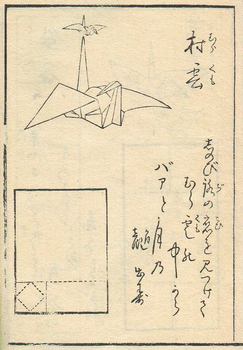
Origami takes fold
It is no surprise that information technology is during the Edo era that recreational folding gained its foothold in Japan. During this long catamenia of relative peace across the land, the Japanese economy grew apace and there was a dramatic flourishing of the arts as patronage broadened to include the newly affluent merchant grade. Much of what we recognize today equally the Japanese artful dates from the Edo period.
Information technology is through ukiyo-due east that we can see how widespread in Japanese society paper folding had become. This nearly egalitarian of art forms often pictured scenes of everyday life. These provide bear witness of kimono fabrics with origami designs and of ladies holding their folded creations.
The spread of origami was also aided by the flourishing of the paper-making industry during the Edo period, creating a plentifully supply of this essential raw material. (7) It is thought that by the end of the Edo menstruation more than than 70 shapes were known including the crane, frog and helmet (eight) - all staples of any beginner folder today. However, at this time origami was still largely an oral tradition and as circuitous designs were difficult to call back, those that proliferated were necessarily elementary.
Images: correct are three ukiyoe prints featuring origami.
Height - Parody of the Story of the Chrysanthemum Male child (Mitate Kiku Jido), 1765
Y'all can conspicuously meet the instantly recognisable folded crane blueprint on the lady's kimono. (9)
Middle - Verse form Number 84: Monk Shun'e (Hachijyuyon ban Shune Hoshi), from the series "100 Poems past 100 Poets" ("Hyakunin Isshu"), 1844
This close upwardly section from a larger print shows the subject mid-fold with the finished model once more a crane (ten)
Bottom - Orizuru o tsukuru shojo (Making paper cranes), Isoda Koryusai, 1772
2 young women fold paper cranes (eleven)
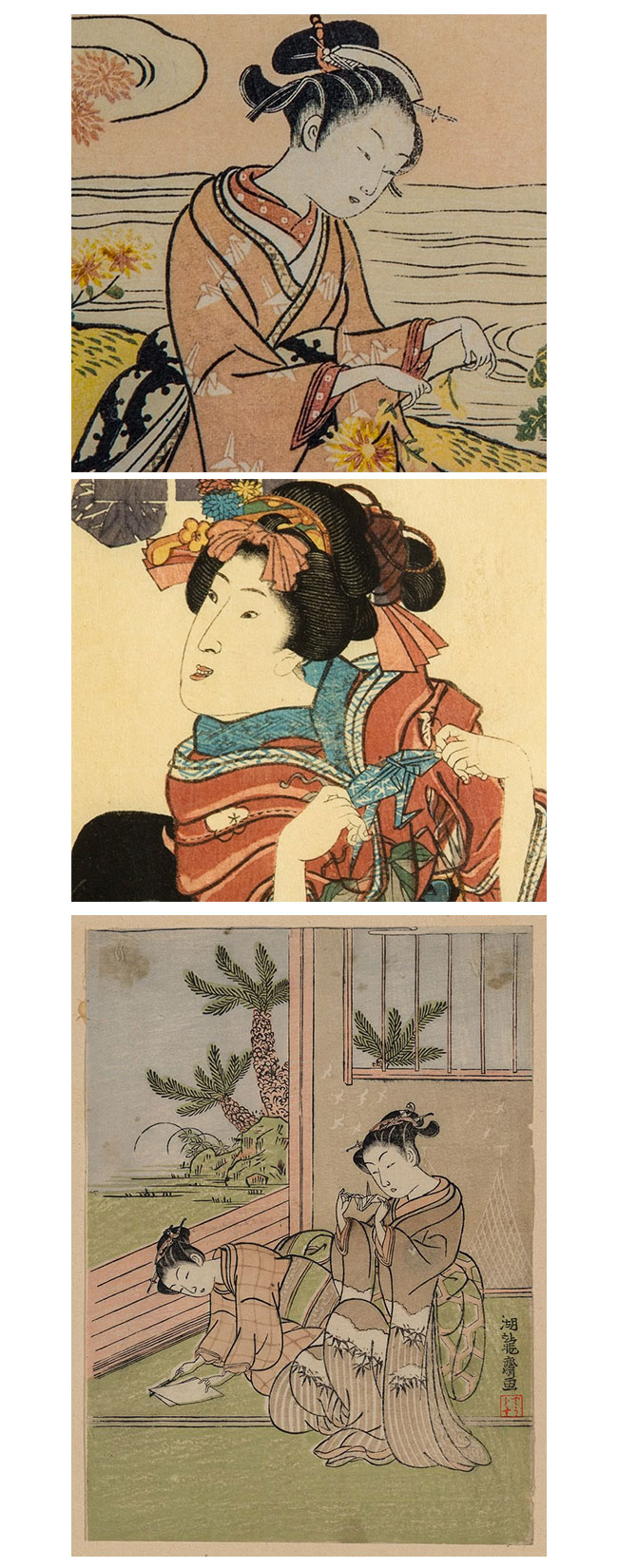
Meanwhile, a long time ago in a continent far, far abroad…
The origins of origami may be mysterious simply one thing we know for certain is information technology's Japanese, right? Recall again! Nourish a fancy restaurant and you may find upon your tabular array an elaborately folded starched white napkin.
In 17th century napkin folding became extremely popular amidst the more well to do of European club, spreading from the courts of Italia to northern Europe. Increasingly elaborate folds were designed to create showy table decorations in the course of animals, birds, sailing ships and other impressive objects. These were created by joining many napkins together, but in his volume of these elaborate table settings published in 1629, Matthew Geiger, included a few designs for the folding of private napkins, of the sort that yous might see at a restaurant today.
Twenty-viii years later, in 1657, this was translated into German and enlarged upon past Georg Phillip Horssdorfer to include more than single napkin designs. Now cloth and newspaper are not the same matter! But Horssdorfer's is the first volume of instructions for folding in a style that origami enthusiasts the earth over would recognise today. (12) The image top right is of such folded napkin designs (Deutsche Fotothek via Wikimedia Commons{PD-1923})
Whilst the elites of Italy (or more likely, their servants) were folding napkins, it seems the Castilian were folding paper birds, known every bit 'pajarita' (design shown right) which comes from the Latin 'passer', pregnant sparrow. Quite where this design came from nobody knows although Spanish origami historian Vicente Palacios has commented on the similarity of the pajarita blueprint to the astrological square that was used for casting horoscopes as early on every bit the twelfth century. (xiii)
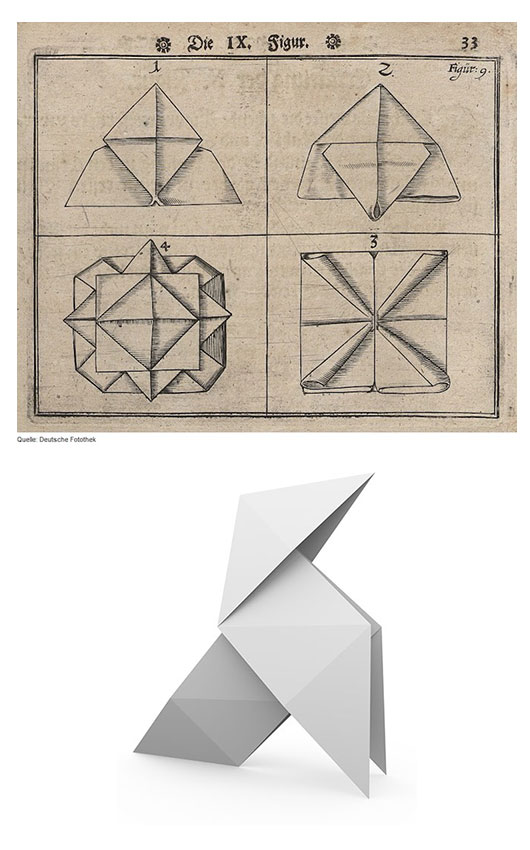
Perhaps the oldest prove for European newspaper folding was likewise discovered by Vicente Palacios. In a 1490 edition of English mathematician and astrologer John Holywood's "Tractatu de Spaera Mundi" (Treatise on the Sphere of the World) is a wood cut illustration of the mechanism of a solar eclipse. Shown in the middle, floating on the bounding main are two boats which acquit a striking resemblance to simple folded paper boats (also sometimes fabricated as hats!). The intentions of the artist are lost in the mists of time, but this certainly could be the earliest known depiction of paper folding (14).
Whether it be designs for napkin folding, simple folded birds, or depictions of folded paper boats, there is reliable evidence that a European tradition of paper folding adult independently of that in Asia.
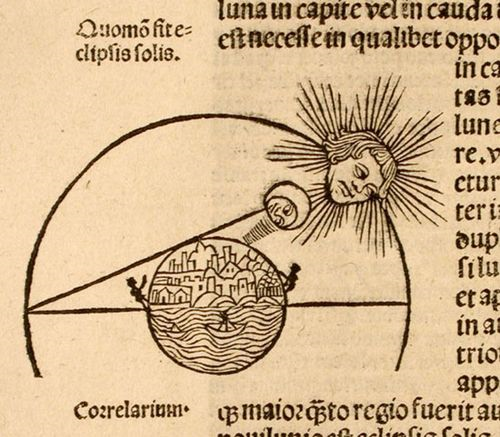
Where Due east and Due west collide
It was a German language who peradventure had the biggest influence on the development of the modernistic origami when Friedrich Fr�bel, the creator of the Kindergarten, included paper folding as ane of his "gifts" to children in his early years curriculum. Paper folding was seen as a way children could observe for themselves the basics of geometry, and they were taught the traditional folded designs including the salt-cellar, windmill, sailing gunkhole, the bird (mayhap the Spanish pajarita), and the double boat - uncomplicated folds all well-known today. These were all mentioned in an 1859 French publication "Manual Pratique des Jardins d'Enfants".
Female teachers who studied the Fr�bel method took newspaper folding all over the world. This was even adopted in Nippon, where post-obit the Meiji restoration of 1868 the land was looking to modernise along Western lines and adopted the Kindergarten model as their own for early on years teaching. This in turn led to the widespread production of western manner origami newspaper in Nippon, the 15x15cm squares that we know today. (15)
Flapping birds and jumping frogs
Until the mid-19th century the designs seen in Europe were very simple. We are not sure exactly when, but some time in the 1860'southward and 70's, a time when all things Japanese were the height of fashion in western Europe, that Japanese conjurers came to Europe and entertained crowds with astonishing new paper folds such every bit the flapping bird and jumping frog. This is when origami really found its legs in the West. Diagrams illustrated by French wood engravers were published in French republic, Federal republic of germany and England, where they appeared in the Boys Ain Paper on 26th June, 1886.(16)
For anyone who has ever folded the flapping bird, it is easy to sympathize the joy of pulling the tail and watching the wings flap.
It was the bases from which these models were folded that created a true revolution in paper folding.
Akira Yoshizawa � the Grandmaster of paper folding
Born in 1911, Yoshizawa was perhaps the outset true origami model making genius. He learnt origami every bit a child before rekindling his involvement in folding when he used it to sympathize and communicate geometrical problems in his job as a technical draftsman. (17)
In 1954 he published 'Atarashi Origami Geijutsu' (New Origami Art). This revolutionary piece of work introduced a system of annotation for origami diagrams (which is largely what is used today) likewise as gifting to the world a huge number of new and highly realistic models of animals, insects, fish and birds. He devised ways to create multiple points through folding solitary which removed the necessity of making cuts and opened up enormous possibilities as to what could be achieved through folding a single square of paper.
Yoshizawa likewise invented a make-new origami technique called 'wet-folding'. This involved dampening thick washi newspaper get-go and molding the newspaper into soft folds to create rounded and incredibly lifelike models which are more alike to paper sculptures than traditional origami models. (eighteen)
Yoshizawa's influence on mod origami cannot be overstated. He passed away in 2005 on his 94th altogether, living long enough to see the next revolution in origami take hold - the rise of the mathematicians.
The ascension of the mathematician folders
Every bit Friedrich Fr�bel has recognised in Germany in the mid-19th century, paper folding is essential a physical expression of geometry and by extension, mathematics. In the 1980s origami enthusiasts such equally Robert Lang in the US began to explore what was possible past applying mathematical principles to the creation of origami models.
Whereas Yoshizawa used his natural flair and noesis geometry to create thousands of new models, Lang analysed the cadre mathematical principles of origami and used these to create a computer program, Tree Maker (free to download from his website), to assistance him design infinitely more complex models than had ever been seen earlier. His extraordinarily lifelike insects are a true coming together of fine art and science and Lang has continued to push the boundaries of what is possible through folding.
Information technology is hard to encompass when viewing his creations and those that take walked in his footsteps, that is possible to create such models from one single square piece of paper through nil other than folding.
Images
The image top correct is Robert J. Lang'southward Scorpion Varileg. The lower image is Lang'south Pill Bug. Both are folded by Gilad Aharoni. To view more images of his stunning folding (and to purchase origami books) visit his website - https://world wide web.giladorigami.com
Lang has specialised in applying his knowledge of folding to real world situations, including folding patterns for a High german airbag manufacture and another out of this world technology solution - profitable the designers of a powerful space telescope with folding the 100m (328ft) thin membrane lens into a minor rocket in such a way that the lens can be unfolded in space and will non suffer from any permanent marks or creases. (19) A truly extraordinary application of the science of origami.
Nosotros highly recommend taking 18 minutes out to lookout man Robert Lang's boggling Ted Talk on origami. You lot volition never await at a square piece of newspaper the aforementioned fashion again!
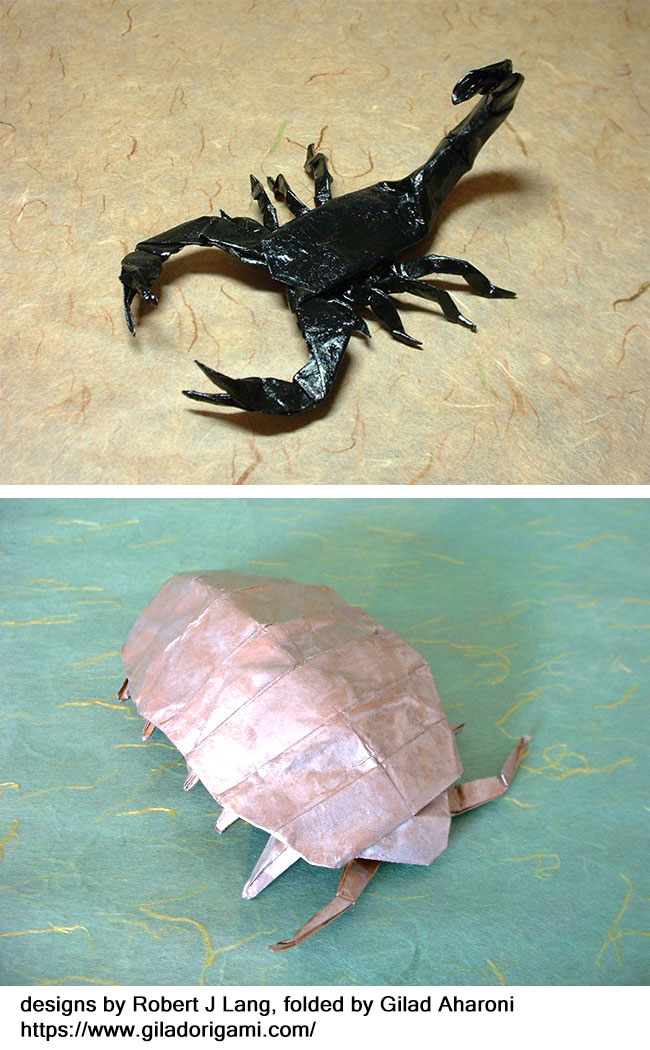
Origami takes over world!
Like so much of Japanese civilisation that has gradually seeped into our lives in the West in the last 50 years, origami is hither to stay. Next time you lot are out and about look around and more likely yous will see some examples of origami. It is all around u.s.. In advertisements, on posters in store windows, on greetings cards, fabric prints, in the designs of lampshades and every now and over again, you'll even come across a real life folded paper crane placed on your table in a restaurant or a bar.
And origami is increasingly being expert by millions of people of all ages and backgrounds across the earth for the shear enjoyment and sense of accomplishment that comes from turning a humble 15cm x 15cm square of paper into a recognizable object but by folding.
If you lot have never folded a newspaper crane, or a simple frog, why not give it a become and detect for yourself that life is ameliorate with folds.
Appendix
How origami got its proper name
The word "origami" used to refer to recreational paper folding is a relative newcomer. As long ago as the 12th century it was used to refer to a horizontal, rectangular sheet of paper called "tategami" which was folded in half latitudinally. These "origami" were used for lists and messages and are still used for lists of formal betrothal gifts today - dorsum to the ceremonial routes of paper folding!
In the Edo era folded "origami" papers came to be used for certificates (such as that denoting the authentic manufacture of a Japanese sword). Curiously, this usage is much the aforementioned as the Greek word "Diploma", which means a folded certificate, and which is used today as a document of academic qualifications. (Lister, 2003)
In the Edo era recreational paper folding was called "Orisue" (literally "folded setting down) or "origata" (folded shape). Later on this became the more prosaic "orimono" (folded matter) which persisted upward until the 1930s. The much more than literal "origami" (folded paper) began to be used towards the end of the 19th century (xx)
Interesting origami facts
ane. Paper folding can be traced dorsum to its use in ceremonies in Japan some 1000 years agone
2. The models of European classic origami were largely based on creases of 45 degrees, making them platonic for teaching the principle of geometry, whereas Japanese ones such every bit the Crane or Frog were based on those of 22.v degrees.
3. The now classic thin, square origami paper originates from Europe not from Nihon
4. In Nippon there were no difficult and fast rules almost cutting or sticking. This came later when European folding composite with Japanese folding
5. Origami was introduced into Japanese schools in the Meiji menses shortly after 1868 when they adopted the German kindergarten system of early years education which included paper folding on the curriculum
vi. Origami wasn't chosen origami until the late 19th century. Before then it was known as Orisue, Orikata and Orimono
seven. The Castilian have their own word for origami - "papiroflexia"
viii. Some people think Leonardo Da Vinci was a newspaper binder? merely sadly in that location actually is no evidence for this
Something to sentinel
Between the folds (2008)
This 2008 documentary chronicles the stories of 10 modern-day newspaper folders, a collection of theoretical scientists and fine-artists who are re-defining what is possible with paper folding. Whether you are a smashing practitioner of origami or are new to the art, you will observe this a fascinating journey into the space where science, art and philosophy run across.
Watch on Documentary Heaven
The math and magic of origami (2008) - Robert J Lang, Ted Talk
Robert Lang is the world's most preeminent practitioner of mathematical origami. His discovery in the 1980's of the iv core mathematical principles of origami revolutionised the art form and re-defined what was possible from folding a single square sheet of paper. In this Ted Talk from 2008 Robert explains those core principles and how he has used them to create everything rom hyper-realistic models of insects, to assisting engineers with the design of a new space telescope.
Scout on YouTube
Something to attempt
The book of mindful origami - Samuel Tsang
Origami has been shown to help relaxation, concentration, manus-middle coordination and retention. At that place is a soothing quality almost following a pattern of folds and turning a flat slice of paper into a recognisable 3D object.
Origami teacher Samuel Tsang has authored this beautifully designed volume with clear pace-by-step instructions on how to fold 16 different models to encourage meditation, dispel negativity, and encourage the magic of mindfulness into your daily routine. If y'all haven't folded earlier, this is a good place to become started.
Society from Amazon
http://mindfulorigami.com/
Sources
The history of origami is a challenging field of study to investigate. Virtually of the work in has been washed by dedicated enthusiasts of which there are many, but we must reserve special mention for David Lister (1930-2013) who is rightly considered to have been the world's leading origami historian. Much of the material in this commodity is based upon his inquiry which he conducted over a lifetime of promoting and advancing the cause of origami.
David was 1 of the founder members of the British Origami Society in 1967 and served as Chairman from 1971 to 1975 and as President from 1998-2002. Information technology is impossible to overstate the contribution that David fabricated to the understanding of the evolution of origami. Much of his work was published via the BOS as the Lister List. For anyone interested in learning more about the development origami would be advised to offset here!
Below is a full list of the sources used in this article:
Wikipedia - History of origami
BOS - Notes on the history of Origami (John Smith)
BOS - The history of paperfolding : a German perspective (David Lister)
BOS - Onetime European Origami (David Lister)
BOS - Errors and misconceptions about the history of paperfolding (David Lister)
Origami Heaven - History of tsutsumi
Origami Heaven - Origami design history
Origami Resource Centre - History of origami
Origami Resource Center - Noshi
Origami Resource Center - Mecho and ocho
Encyclopedia Britannica - History of origami
K's Origami - History of origami (Koshiro Hatori)
The Spruce Crafts - A brief history of origami
Origami United states - History of the "Kan no mado" dragonfly
My Modern Met - Origami: How the aboriginal fine art evolved over fourth dimension
Joseph Wu Origami - Origami: A Brief History of the Ancient Art of Paperfolding
All virtually Japan - The history of origami
Featured trips
Source: https://www.insidejapantours.com/japanese-culture/origami/
0 Response to "Baby Origami Maybe You Can Change It Up"
Postar um comentário